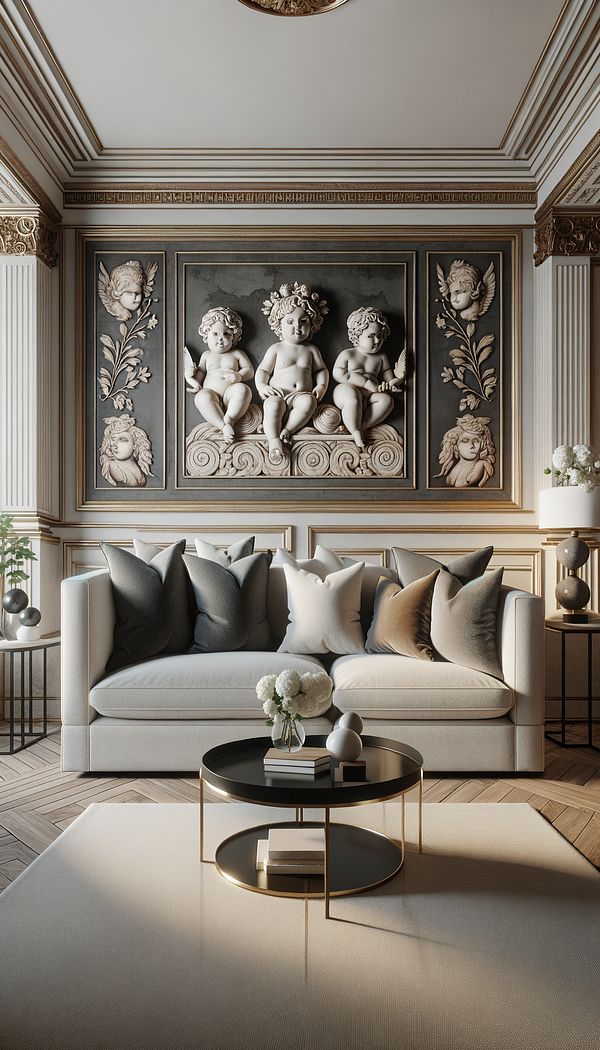What is Amorini?
Amorini are decorative motifs featuring cherubic children, often depicted with wings.
Description
Amorini, charming and whimsical elements in the world of interior design and art, are motifs that comprise cherubic children, frequently illustrated with wings, reminiscent of classical Cupid figures. These figures are rooted in classical antiquity and Renaissance art, symbolizing innocence, divine love, or the soul's ascent to heaven. In interior design, Amorini may appear in various forms - as statues, frescoes, bas-reliefs, or architectural ornaments, bringing a touch of ethereal beauty and historical depth to spaces.
The use of Amorini can significantly enhance the aesthetic of a room, infusing it with a sense of grace and timeless elegance. These motifs are particularly prevalent in designs that lean towards classical, baroque, or rococo styles, where the emphasis on opulence and detailed ornamentation aligns with the delicate beauty of Amorini. Integrating these motifs into modern spaces can create an intriguing contrast, blending classical elements with contemporary design to create unique and captivating environments.
Usage
Amorini can be found adorning the walls of a classic Italian villa, intricately carved into the woodwork of antique furniture, or even depicted in modern wallpapers and textiles. Their versatile nature allows them to be incorporated into a variety of settings, from luxurious spa bathrooms to elegant living rooms, adding a historical layer and visual interest to the decor.
FAQs
-
Are Amorini and cherubs the same?
Yes, Amorini and cherubs are often used interchangeably in the context of interior design and art. Both terms refer to depictions of winged children, embodying themes of love and innocence.
-
Where are Amorini most commonly used?
Amorini are most commonly used in spaces that embrace classical, baroque, and rococo styles, due to their historic and ornate characteristics. However, they can also be adapted to fit modern or eclectic interiors as decorative accents.
-
Can Amorini be integrated into contemporary design?
Yes, Amorini can be integrated into contemporary design by using them as decorative accents that offer a contrast to minimalist elements, or by choosing modern interpretations of these motifs in art and decor.
Practical Application
To incorporate Amorini motifs into your space, consider adding them as decorative sculptures, wall art, or even as intricate patterns on textiles like curtains or throw pillows. For a subtle nod to classical elegance, look for wallpaper or fabric designs featuring Amorini. When using these motifs, balance is key — too many can overwhelm a space, so use them sparingly as delightful accents.
-
Decorative Objects240 articles
-
Historical Periods & Movements150 articles
-
Art & Sculpture30 articles
-
Textiles & Upholstery252 articles
-
Wall Treatments & Finishes157 articles
-
BaggingBagging is a decorative wall finish obtained by applying a thin cement-based layer to walls and then manipulating it with a sponge or cloth.
-
AcanthusAcanthus is a decorative motif used in interior design and architecture, characterized by stylized leaves of the Acanthus plant.
-
SymmetrySymmetry in interior design refers to a balanced distribution of visual weight on either side of a central axis.
-
Slant-Front DeskA slant-front desk is a type of writing desk with a hinged writing surface that slopes downwards when opened.
-
Channel QuiltChannel quilt is a quilting technique where fabric is sewn into elongated, parallel channels, creating a distinct linear pattern.
